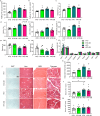Metabolic reprogramming by Acly inhibition using SB-204990 alters glucoregulation and modulates molecular mechanisms associated with aging
- PMID: 36890357
- PMCID: PMC9995519
- DOI: 10.1038/s42003-023-04625-4
Metabolic reprogramming by Acly inhibition using SB-204990 alters glucoregulation and modulates molecular mechanisms associated with aging
Erratum in
-
Author Correction: Metabolic reprogramming by Acly inhibition using SB-204990 alters glucoregulation and modulates molecular mechanisms associated with aging.Commun Biol. 2025 Feb 12;8(1):220. doi: 10.1038/s42003-025-07659-y. Commun Biol. 2025. PMID: 39939695 Free PMC article. No abstract available.
Abstract
ATP-citrate lyase is a central integrator of cellular metabolism in the interface of protein, carbohydrate, and lipid metabolism. The physiological consequences as well as the molecular mechanisms orchestrating the response to long-term pharmacologically induced Acly inhibition are unknown. We report here that the Acly inhibitor SB-204990 improves metabolic health and physical strength in wild-type mice when fed with a high-fat diet, while in mice fed with healthy diet results in metabolic imbalance and moderated insulin resistance. By applying a multiomic approach using untargeted metabolomics, transcriptomics, and proteomics, we determined that, in vivo, SB-204990 plays a role in the regulation of molecular mechanisms associated with aging, such as energy metabolism, mitochondrial function, mTOR signaling, and folate cycle, while global alterations on histone acetylation are absent. Our findings indicate a mechanism for regulating molecular pathways of aging that prevents the development of metabolic abnormalities associated with unhealthy dieting. This strategy might be explored for devising therapeutic approaches to prevent metabolic diseases.
© 2023. The Author(s).
Conflict of interest statement
Patent details: Inhibidores de la ATP-citrato liasa como agentes geroprotectores, P202230801, V.C.G., A.M.M., Spain. All other authors declare no conflict of interest.
Figures







References
Publication types
MeSH terms
Substances
LinkOut - more resources
Full Text Sources
Molecular Biology Databases
Miscellaneous

